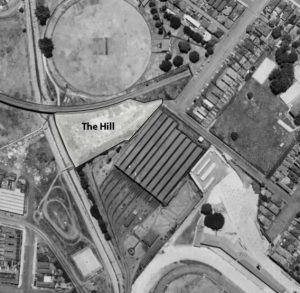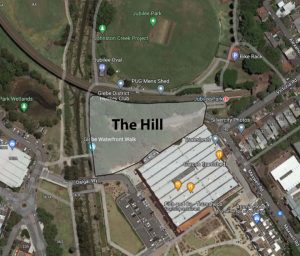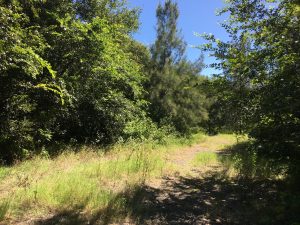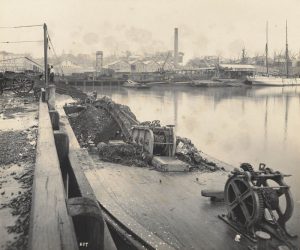
by Andrew Wood, Blue Wren Subcommittee Convenor, Bulletin 6/2022, August 2022
‘The Hill’ is a fenced-off area of contaminated Crown land on the northern side of the Tramsheds. The Glebe Society has recommended that the site should become an undisturbed urban nature refuge.
Summary of historical background
by Max Solling, local historian and Honorary Life Member of the Glebe Society.
- The Hill on the fringes of the then Lilliebridge Running Grounds (later Epping racecourse and, from 1929, Harold Park) became the major local garbage tip (Epping tip) from 1890 to about 1910.
- In 1901, Glebe Council had accepted the tender of McEnally Brothers to haul tons of house garbage by punt out to sea for dumping, operating every alternate day. Nearly all Sydney councils had discontinued this practice by 1914 but not Glebe; in 1922 Glebe punted 90 tons of house garbage weekly out to sea. In 1932, Glebe was the only municipal body still dumping garbage at sea. The practice ceased when Glebe’s incinerator in Forsyth St, next to the Council depot, began operating in July 1933.
- In 1909 an area of about 13 acres at Glebe was dedicated for public recreation and called Jubilee Park.
- In 1913 it was decided that a new Glebe Island railway line was to pass through Jubilee Park with a tunnel built under Glebe Point to connect with Pyrmont and Darling Harbour. Tenders were let from 1918 for the supply of stonework in the viaduct across Jubilee Park and the railway line opened on 23 January 1922.
- Glebe Council’s health inspector Mr Young stated in July 1926 that Epping racecourse was formerly a garbage tip and was altogether unfit for building purposes. Refuse had been found even at a depth of 16 feet. The Board of Health had already declared the land unfit for residential purposes (‘Epping Course – Not to be built upon’, SMH, 19 July 1926, p.13).
- Following its use as a tip, The Hill became a paid carpark for patrons of Harold Park’s trotting and dog racing events. The construction of the Rozelle Tram Depot adjacent to The Hill was fully completed in 1909 and housed 195 trams; it ceased operating in 1958.
Comment about The Hill from ‘I Own the Racecourse!’
by Helen Randerson, member of the Glebe Society’s Blue Wren Subcommittee.
Patricia Wrightson, in her 1968 book, I Own the Racecourse!, described The Hill as:
a small corner of vacant land …The ground was covered with rank grass, scraggy bushes, old cardboard cartons and a scattering of tins and bottles. A great old Port Jackson fig hung over a fence behind it … A lane ran off from one corner. In the mouth of this lane and under bushes and deep in the shadows of the fig, green and yellow eyes blinked and widened where the brave, shabby cats were hiding.
The Hill: a valuable biodiversity site
by Judy Christie, member of the Glebe Society’s Blue Wren Subcommittee, Convenor of the Orphan School Creek Bushcare Group and Leader of the Society’s annual spring bird survey.
Community engagement in the 1990s: Volunteers working with the Rozelle Bay Community Nursery in the mid- to late 1990s planted native plants, including Casuarina sp, on the south-east edges of The Hill site. Common birds at that time, observed by volunteers, included Superb Fairy-wren, Silvereye and White-plumed Honeyeater, as well as various non-native species. Plantings came to a halt when the light rail stop at Jubilee Park began construction and The Hill was closed off from about 2000.
Current biodiversity values: The Hill is a Crown land site and has been included as one of the sites in the annual Glebe Spring Bird Survey. Sightings have included Brown Goshawk and Australian Brush Turkey. However, without site access, it is impossible to ascertain whether other species might be present, including reptiles, microbats or other native species.


Aerial views of Glebe in which The Hill is outlined to show its approximate boundaries between the Tramsheds and the light-rail railway line. The image on the left is from the 1949 Arial Survey (Sydney Historical Atlas); the image on the right is from Google maps)
The Hill does have some good patches of lantana, which, although not native, is now recognised as providing important habitat for small native birds. It also attracts insects like the Blue Triangle butterflies commonly seen there. Apart from The Hill, most lantana shrubbery has now been removed in the vicinity of Johnstons Creek. There have been no local sightings of birds such as Superb Fairy-Wrens since 2017, although further southwest along the light rail corridor, there are substantial lantana patches and small native birds are still common.
Installing wildlife cameras and acoustic recorders to gather information on current species present and/or threats to wildlife could be an initial step to establishing The Hill as a native wildlife protection area.

Establishing The Hill as a feral-free biodiversity haven: Creating undisturbed habitat – especially small bird habitat – in the Johnstons Creek corridor is very challenging because of the heavy pedestrian traffic, bikes and dogs. Although there are some bush restoration patches, most patches are too fragmented, suffer from vandalism or focus on canopy cover, which limits dense understory.
The Hill represents the best opportunity to create an undisturbed urban nature refuge in the Johnstons Creek corridor, where plants and native wildlife are protected from disturbance. Such a refuge could also create opportunities for future urban nature research projects.
The Glebe Society and its Blue Wren subcommittee are requesting that Council consider:
- Undertaking feasibility studies to develop options for transforming the site without expensive remediation and with staged removal of non-native trees and vegetation. Options could include cutting trees to ground level and spraying out weeds before covering all with a deep layer of soil or crushed sandstone, followed by shallow re-planting.
- Investigate feral-free fencing options that do not involve extensive excavation.
Meeting with City of Sydney to consider the Society’s proposals for The Hill
by Andrew Wood, Blue Wren Convenor
An online meeting was held on Tuesday, 5 July, to discuss the Society’s proposals. The meeting was chaired by Cailin Martin (Property Strategy Planner). Also attending from the City were Jacqui Brooks (Parks Assets and Services Manager) and James MacNamara (Urban Ecology Coordinator). The Glebe Society was represented by the President and six members of the Blue Wren Subcommittee. Our 2022 Biodiversity lecturer, Professor Dieter Hochuli from the School of Life and Environmental Sciences, Faculty of Science, University of Sydney and leader of its Integrative Ecology Group, was also present.

The following decisions were made at the meeting:
- The City has no objections and supports the monitoring of wildlife on The Hill, including the use of cameras and acoustic recordings, which could be undertaken by Professor Hochuli’s group at the University of Sydney.
- The Hill is subject to an Aboriginal land claim, but the City recommends that the site be monitored for wildlife as an interim measure. The ownership of The Hill may be transferred to the Metropolitan Aboriginal Land Council, which would then make final decisions about the site.
- The City would probably fund any future remediation of The Hill.
- The City will organise an onsite inspection of The Hill once the weather has improved.
- The City will send the Blue Wren Subcommittee details of community grants that could be used to fund the monitoring proposals.








One comment. Please add yours.
As a regular visitor & occasional resident in Glebe for 25+ years & reader of the Glebe society bulletin, I was mystified by references to Glebe hill in the June 2023 bulletin, a place I have never come across, a location seemingly without an address & one that delivers ‘no results’ on a google maps search. So I am grateful to have come across this article & photographs. Thank you v much.